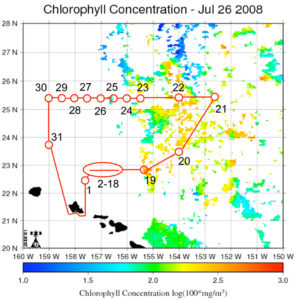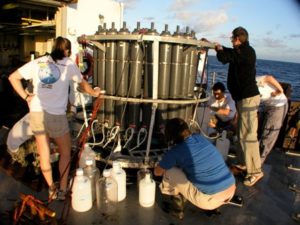
Thursday, July 31, 2008
The scientists onboard are conducting a variety of experiments, all of which require participants from the microbial world. These scientists need the little microscopic critters that inhabit the Earth’s oceans. So, how do you find critters that exist on a scale where a million of them could fit in a teaspoon and you’re looking in an ocean? Satellites start the search by measuring how much light is reflected from the water’s surface. Plant plankton, known as phytoplankton (fi’-toe-plank-ton), contains chlorophyll and absorbs sunlight that reaches the ocean surface. When less light is reflected, the satellite data indicates the presence of plankton. The satellite image shown here is being used by the R/V Kilo Moana crew to navigate the scientists toward the plankton.
The first plankton sample was taken this morning at 2:00AM and sampling will continue throughout the research cruise. Sampling is completed using an instrument called a “CTD,” which stands for Conductivity, Temperature, and Depth. Long sampling tubes are mounted around the CTD sensors, which are located in the center of the instrument. A winch, mounted on the deck of the ship, is used to deploy the CTD and lower it to the designated depth in the water column. Once the CTD is brought back to the ship, the scientists can collect their water samples and begin their experiment

s.
As we transit toward the more concentrated areas of chlorophyll (and phytoplankton), we will approach a plankton “bloom.” Blooms are highly concentrated populations of phytoplankton. Create your own plankton bloom over the next few days by completing “Today’s Activity” posted below. (Be sure an adult is with you when you visit a pond to collect your water. Remember: Safety First!)
Today’s Activity: Create a Plankton Bloom
Collect 1/2 liter (about 2 cups) of pond water in a glass jar. Place the uncovered jar on a window sill for 4 days and observe the changes each day. Use a table like the one below to assist you with your data collection:
| Observations | DAY 1 | DAY 2 | DAY 3 | DAY 4 |
| Illustrations | ||||
| Notes |
Prediction Questions:
- Will there be change in the water color?
- Why or why not?
- How can you measure a change in color?
- Will there be a change in the volume of the water?
- Why or why not?
- How can you measure a change in volume?
- Will there be a change in the pH of the water?
- Why or why not?
- (OPTION: Use Swimming Pool test strips to measure the pH each day.)
- How will you determine if a plankton bloom has occurred?
<== PREVIOUS ENTRY ==> NEXT ENTRY
